|
|
|
| Cava despre Dj DnB | |
|
|
|
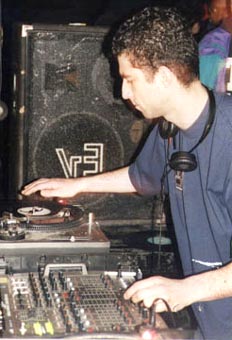 |
DJ Hype Much is made of breakbeat's inclusiveness that your colour doesn't matter as long as you worship at Jungle's temple of boom. With a series of implausibly funky tracks and a DJing style that owes more to hip-hop than perhaps any other Junglist, DJ Hype, a white guy from London's East End, epitomises drum 'n' bass' colour blindness. Hype started out DJing in the early '80s on a sound system he set-up with PJ and Smiley, who would eventually become Shut Up and Dance. In 1989, Hype (under the name Doctor K) won the European DMC mixing championships and his hip-hop-honed turntable skills have paid handsome dividends in his career as a breakbeat DJ. Along " with Danny Breaks, Hype created part of early Hardcore's exhilaration by bringing scratching into the music an awesome feat at 150-plus bpm. When Hype landed a job at London pirate station Fantasy FM in 1989, he would layer House music over hip-hop beats played at 45 rpm in order to get a presciently breakbeat feel. Through his connections with Fantasy and SUAD, Hype became the in-house producer and A&R man at Kickin' Records. As The Scientist, Hype recorded some of rave's first forays into breakbeat and darkness (albeit with an almost camp pomposity) with "The Bee" and "The Exorcist" (1990) and "The Kick Squad" (1991). During this time, he was also building a reputation as the most formidable DJ on the scene and was voted Fantasy's best DJ. His first track as DJ Hype, "Shot in the Dark (Gunshot Mix)/1 Can't Understand It (Scratch The Fuck Out Of The Beginning Mix)" (1993), was released on Suburban Base and served as a blueprint for Hype's future excursions into lightning-speed hip-hop mutations. The remixes were accompanied by the mind-boggling "Weird Energy" which was a stunning combination of wind chimes, Mentasm synths and a hyper- speed cut-up of The 45 King's "The 900 Number". As great as his early tracks were, they were nothing compared to "Rrrroll da Beats" (1994). Just as Jungle was being divided by the "intelligent" movement, "Rrrroll da Beats" proved that Jungle's raison d'etre, breakbeat science, was more exciting, more challenging and more intelligent than any smarmy Fender Rhodes lick. Not only did it have a stunning variation on the "Think" beat and a bassline that would come to define the jump-up and Hardstep sub-genres, it had actual hooks courtesy of MC GQ whose refrains "Absolutely 'T' for tremendous" and "Wheel up, come again, please, please, please" echoed around London for a year after its release. 1994 also saw the formation of Hype's Ganja label, which was inaugurated by the release of the dancefloor anthem "Computerised Cops". Released under the moniker Dope Style, "You Must Think First" (1994) was little more than a kung-fu flick sample and a video 90 game effect on top of an oscillating bassline and rolling, tumbling breakbeat that epitomised Hype's production style. Ganja would continue to release floor-filling rinse-outs like "Mash Up da Place" and "Pum Pum Must Smoke Ganja" (both 1995), but its biggest success would be DJ Zinc's "Super Sharp Shooter" (1996). The Malcolm X-sampling "We Must Unite" (1996) displayed Hype's extraordinary low-end sensibilities with a rubbery, almost sing-song bassline that was murderous on the dancefloor. "We Must Unite" was featured along with tracks by Pascal and Zinc on the enormously successful Still Smokin' (1996) compilation which was the genesis of their True Playaz label and collaborations as the Ganja Kru. Hype's best, certainly most devastating, moment, though, might be his semi-legal mix of Ready or Not" (1996) which redefined "tearing". When the True Playaz posse shifted their focus away from the dancefloor as on the Real Vibes collection (1998), however, their sense of dynamics got lost in the effort ) make an album that worked as well at home as it did in the club. |
| Ed Rush With beats that are not so much block-rockin' as knock your block off, Ed Rush is probably the undisputed king of the new wave of noir that has swept drum 'n' bass. The brutally industrial sound that he helped bring back into fashion with collaborators DJ Trace and Nico at -No U Turn Records ruled drum 'n' bass for the better part of two years and has positioned Ed Rush as one of breakbeat music's leading figures Born Ben Settle in west London, the young Ed Rush was a b-boy who, in the usual traiectory, had tuned on to rave because of the breakbeats . he pestered neighbour Nico Sykes who was a engineer with his own label, to produce tracks with him. The result was "Blud- clot Artattack" (1993), a disturbing Darkcore track recorded in Sykes' cramped, collapsing loft that didn't have the pulsating momentum of other dark tracks and marked Jungle's transition away from the Ecstasy rush towards the blunted bloodshot detachment of marijuana. After disappearing from the scene for two years, Ed Rush re-emerged as agent provocateur on Trace's epochal "The Mutant" (1995). His return as Ed Rush, "Guncheck" (1995), was characterised by seething gangsta attitude and sneering basslines. The flip, "Force Is Electric", had a nasty snatch static that sounded like a short-circuiting wire or a mosquito flying ir an electric lamp running through the track. His contribution to 1 scene-defining Techsteppin' (1996) compilation, "Check Me Out", had all the ferocity of gangsta Hardstep tracks released by the Dope Drag- on and Philly Blunt labels, but it felt sapped of energy, foggy, depleted The Skylab EP and "Kilimanjaro" (both 1996), released on Metalheadz and Grooverider's Prototype labels respectively, marked the acceptance of his hideously distended distorted bass sounds (achieved by running the synths through a guitar distortion pedal) by the drum âÂËœ n' bass mainstream. With rigid drum intros and oppressive, coagulating bass sounds, "Skylab" and "The Raven" (from the Skylab EP), in particular, seemed to presage the next two years of drum 'n' bass. The equally dystopic "Mothership" (1996) began like the sound track to an Agatha Christie murder-by-the-docks tale and slowly turned into a Dario Argento splatter-fest with punishing drums and a bassline of Rabelaisian proportions. With its grandiose synth stabs and thunderous bass chorus, "Technology" (1997), which anchored No U Turn's Torque compilation, was of an almost Wagnerian vision of sonic violence. Ed Rush also contributed a mix session to Torque which included his perfectly titled no "Comatone" (1997) -the clockwork rhythm and the bass were so claustrophobic and dense that the track was almost desensitising. By this time Ed Rush was a bona fide star on the scene and he 10- hooked up with another figure who was defining drum 'n' bass' uncompromising new sound, Optical (who had engineered the Skylab EP), to form the Virus label. The label's first two releases, "Medicine/Punchbag" and "Zardoz/Satellites" (both 1998), were, despite the bass distortion, marked by the unrelentingly clinical production values and obsessively precise drum programming that was The the hallmark of the two-step sound that was moving drum 'n' bass away from its breakbeat roots. These singles, along with tracks like the into sort of jazzy "Glass Eye" and the bass-heavy "Slip Thru", were collect- the ed on the duo's Wormhole album (1998). |
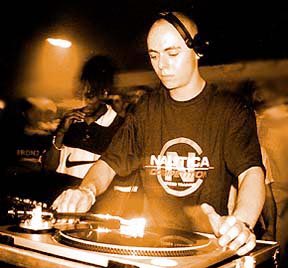 |
|
|
Mickey Finn Unintentionally taking his name from slang term for an alcoholic beverage that's been spike with drugs, Mickey Finn, (nè Michael Hearne) started adulterating House music's pristine blueprint with a raver's sensibility in 1988 when he began DJing at his sister's club in south London. Moving away from the soothing Balearic bliss that predominated in clubland, Finn was one of the pioneering exponents of the breakbeat sound and ushered in the Hardcore era with his appearances at raves like Biology and Gene- sis. While his enduring influence will be as a DJ, as a producer in his own right Finn has created some of the most abiding tunes in the breakbeat continuum. Using the alias Bitin' Back (also the name of his record store in Gravesend), Finn extensively sampled the intro of The Six Million Dollar Man for his exhilarating "She's Breaking Up" (1991) which was released on Tim Taylor's American Focus label. Forming Urban Shakedown with long-time collaborator Aphrodite and Claudio Guissani in 1992, Finn was responsible for one of Hardcore's eternal classics, "Some Justice". Based around a deceptively simple oscillating keyboard riff and a breakbeat swiped from an old Run DMC record, "Some Justice" exploded into the British Top 20 on the back of a sample of CeCe Rogers' "Someday" that warped his vocals until they sounded like the benediction of a helium angel. Far less heavenly was the bass cauldron of a club called AWOL where Finn was a resident DJ alongside Randall, Kenny Ken, Dr, S Gachet and Darren Jay. Beginning in 1992 at north London's Paradise Club, AWOL (A Way of Life) was a pressure chamber of dense, low-end frequencies punctuated with the stench of lighter fluid and piercing cacophony of air horns that replaced Rage as the unofficial headquarters of Junglism. It was here that Finn became one of the patron saints of jump-up with his sets of militantly minimal, hip-hop-sampling tracks with ricocheting break- beats. In between weekends spent criss-crossing the country to fulfil his DJing commitments, Finn re-emerged as Urban Takeover with Aphrodite in 1997 with the irrepressibly funky "Bad Ass!" The New Birth-sampling track was released on their own Urban Takeover label which has since introduced the world to new talent like Natural Born Chillers and Mulder. With their remix of the Jungle Brothers' "Jungle Brother" (1997) reaching the British charts in 1998, Aphrodite and Mickey Finn deservedly became two of drum 'n' bass' highest-profile names. |
|
Goldie
If there is one person who represents drum 'n' bass for the main- stream media it is Goldie. With natural charisma and a larger-than- life personality, Goldie is one of the few producers, in a scene that once thrived on its anonymity, who is able to fit into the music industry's established promotional machine. While his stardom may be not unconnected with his willingness to play the celebrity game, the roots of his reputation lie in the ground-breaking Darkcore tracks that he produced in the early '90s, which created the foundation for Jungle's above-ground cross-over. Born in Walsall in 1966 to a Scottish mother and an absentee Jamaican father, Goldie was raised under sometimes brutal conditions in numerous foster families. After being seduced by hip-hop culture, he moved in 1986 to Miami, where he set up a shop selling the engraved gold teeth from which his nom de disque is derived. Goldie then moved back to England, where he fell in with the Reinforced Records crew, for whom he did both design and A&R work. After a 12" as Ajax Project, Goldie released the completely blissed-out "Men- ace" (1991) using his Rufige Kru alias -"rufige" being his term for the nth-generation samples that he used to give his tracks a dirty, rough edge. This sound was writ large on Dark Rider (1992), an EP characterised by its skittish drums and relentlessly staccato synth stabs which created a tension that was miles away from the giddy energy of most Hardcore of the time. Now recording as Metalheadz, Goldie released what may be the scene's most pivotal track, "Terminator" (1992). Lifting the buzz-saw synth riff from Joey Beltram's "Mentasm" and pitch-shifting the drums so that they stayed in tempo, but got progressively faster, "Terminator" became the ultimate darkside track by mutating breakbeats into something that sounded as out of control and messed up as the omi- nous synths and freak-out spoken-word samples that characterised Darkcore, But just as he epitomised the dark sound, Goldie put down the foundation of its demise with the extraordinary "Angel" (1993), A fusion of blistering breakbeats, "Mentasm"-style synth drones, samples from Brian Eno and David Byrne's My Life in the Bush of Ghosts k and unctous jazz-Iite vocals from Diane Charlemagne, "Angel" was one of the few tracks pushing Hardcore in a more musical direction that didn't forget what made the music so exciting in the first place, Unfortunately, by using the timestretching technique that he pioneered on "Terminator" to keep Charlemagne's voice from veering into helium territory, he also enabled other jazz-fusion-obsessed producers to become as smarmy as their idols. Goldie's fusion fetish continued to pay dividends, however, with the outrageously over-the-top, but somehow rather good, twenty- minute-plus magnum opus about the nature of time and ghetto living, "Timeless" (1994). A beat suite that incorporated the urge to release the pressure of "Inner City Life", the breakbeat dub of" Jah", a pas- sage of massed strings and a reprise of "Inner City Life", "Timeless" was he, brutal urban experience in (not so) miniature. According to Goldie, It was also the ultimate statement of drum 'n' bass's technical sophistication and breakbeat manipulation. "Timeless" was the title track of Goldie's 1995 debut album. Recorded with engineers like Rob Playford, Dillinja and 4 Hero's Dego McFarlane, Timeless was almost universally hailed as a masterpiece upon release. More realistically, it was half mind-boggling ("Timeless" and "This Is a Bad") and half the sort of mawkish fusion ooze inhabited by the likes of The Yellowjackets and Spyro Gyra ("Sea of Tears"and "Adrift"). Timeless marked drum 'n' bass' shift from the populist get-out-of-your-head energy of Hardcore to the elitist "progressivism" of what Simon Reynolds labelled Artcore. With the release of Timeless Goldie became Jungle's unofficial figurehead. His new club, Metalheadz Sunday Sessions at London's Blue Note. replaced LT J Bukem's Speed as the place to be seen and to hear the cutting edge. His newly formed Metalheadz label pushed his cyber-skeleton with headphones logo even further into the public consciousness. By the time of his high-profile relationship with Bjork, Goldie had reached media saturation. The inevitable over-heated reaction to too much press was turned into an album even more overblown than Timeless. With one or two exceptions, Saturnz Return (1998) was everything bad about Timeless magnified twenty times: there were tracks with David Bowie and Noel Gallagher, more ghastly over-ripe fusion moves and an hour-long orchestral piece called "Mother". His former partner, Rob Playford, once said that he hoped that Jungle would become progressive rock for the 21st century. Saturnz Return made his wish come true a little early. A pared-down remix album, Ring of Saturn (1999), helped slightly, but the damage had already been done. |
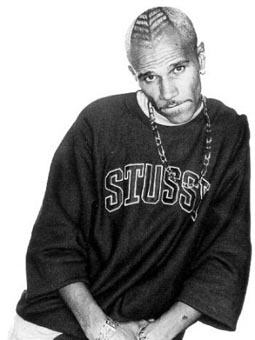 |
|
|
Jumping Jack Frost One of the mainstays of drum 'n' bass, Jumping Jack Frost has had a huge influence on the music, but with little of the fanfare, that other pioneers attract. He got his start by playing rare groove tracks on Brixton's pirate station, Passion FM, and he soon became I one of the first south London pirate DJs to play Acid House. He progressed to playing major events like Sunrise and Energy and soon became one of the most popular breakbeat DJs on the scene. A collaboration with DJ SS, "Pornography" (1993), was his first track. Sampling Ecstasy, Passion & Pain's disco Classic, "Touch and Go" on top of a cheap and cheerful keyboard riff and James Brown's "Funky Drummer" beat, "Pornography" was a brillant example of Hardcore's promiscuity. As Hardcore was splintering into Jungle, drum 'n' bass and Happy Hardcore, Frost hooked up with old friend Bryan Gee and formed V Records in 1993. The label's first release was an EP by two unknowns from Bristol calling themselves The Deceivers. The Fatal Dose EP (1993) marked the arrival of Roni Size and DJ Krust on the scene and the West Country duo would herald V's position of pre-eminence with Size's "It's a Jazz Thing" and Krust's "Jazz Note" (both 1994). Kicking off V's Philly Blunt imprint, Frost produced one of the definitive Jungle tracks with "The Burial" (1994) released under his Leviticus guise. Riding the "Think" beat, Frost looped the same sample of Foxy's "Mademoiselle" that Roni Size used on "Music Box" and punctuated it with a killer ragga sample and some diva vocals courtesy of his sister Yolanda. Philly Blunt represented the more roughneck side of V's jazzy cool, and Size (as Firefox) followed the boss' example with the eternal floor-filler "Warning" (1994) and the mind-boggling rhythm manipulation of "Bonanza Kid" (1995). V, meanwhile, continued to define cutting-edge drum 'n' bass with records like Krust's militantly minimal "Set Speed" (1995) and the post-industrial holocaust of his "Warhead" (1997) and Ed Rush & OpticalâÂâ„¢s "Funktion/Naked Lunch" (1998). Despite some weak beats, the V Classic compilation (1997) made clear the label's claims to greatness with tracks from Size, Krust, Dillinja, Lemon D and Ray Keith. Planet V (1999) was the follow-up and featured Frost's (aka The Punisher) wicked "Resident Evil". V also provided a platform for other Bristol artists like DJ Die and DJ Suv. The two collaborated on "Play It For Me" and "Get on Down/Out of Sight" (both 1996) and "War and Peace" (1997) which was featured on V Classic. As a solo artist, Die released the dark step- per "Reincarnations" (1996), on Full Cycle, as well as "Something Special" (1997) and the techy "Clear Skyz/Reminisce"(1998) for V. |
|
Grooverider
In Junglist folklore no one occupies a more central role than Grooverider (he refuses to divulge his real name), the man nearly) everyone calls "the godfather". Almost universally revered by the drum 'n' bass community because of his commitment to the music since the early days of rave, Grooverider has parlayed this affection into a position of unparalleled power within the scene. As drum 'n bass' main taste-maker and most in-demand DJ, Grooverider has the ability to make or break artists: Goldie, Photek, Optical, Matrix, John E and Boymerang have all benefited from the Rider's conferral. While those outside of his coterie have, perhaps unfairly, suggested that his lives up to his nickname and runs his domain like the Mafia, it is certain nonetheless that where Grooverider goes, the rest of the scene soon follows, Grooverider's path to becoming the king of the Jungle began at a tiny, dingy after-hours club in Brixton called Mendoza's in 1987. Teamed with fellow Choice FM pirate DJ Fabio, Rider played early Acid House 12"s to a small crowd of committed club cognoscenti who would stumble down to south London after Shoom closed. By 1989 the buzz surrounding Fabio and Grooverider had grown to such an extent that they were offered a backroom slot at Heaven -one of London's biggest clubs. In classic clubland style, they were so successful that, in 1990, they took over Heaven's main room for their now-legendary Rage night. According to the accepted mythology, Rage, which ran until 1993, was where the breakbeats of hardcore Techno broke away from mainstream Techno and House and developed into Jungle and drum 'n' bass. Whatever the veracity of this particular creation tale, we can be sure that Fabio played the jazz-tinged straight-man to Grooverider's battering barrage of darkside beats, thus setting in motion drum 'n' bass' rough vs. smooth dialectic. Whether it was the actual DJing skills and musical taste of Fabio and Grooverider that made Rage what it was or just the copious amount of drugs consumed by the clubgoers, the almost mystical aura surrounding Rage ensured Grooverider's enduring prominence. Despite his peerless reputation, Grooverider's first tracks were released almost anonymously (under the psuedonym Codename John) on his then-unpublicised Prototype label in 1994. He dubbed the roughneck style he championed in his DJ sets -typified by tracks like his own "Kindred" (1994) Hardstep, and his two Hardstep Selection (1994, 1995) compilations, featuring tracks by Dillinja, J. Majik and DJ SS, were definitive overviews of the mean and moody sound that characterised drum 'n' bass before its mainstream acceptance. Goldie repaid his enormous debt to Grooverider, who was largely responsible for the success of "Terminator" in 1992, by inviting him to be the resident at the influential Metalheadz Sunday Sessions club. Goldie's Metalheadz label also released Grooverider's fearsome, sirens-at-the-gates-of-hell track "The Warning" in 1997. This sound of technology gone horribly wrong was writ large on Grooverider's The Prototype Years (1997) compilation. As it introduced drum 'n' bass to the skewed visions of producers like Optical, Matrix and John B, The Prototype Years enshrined the sound of malfunctioning machines and obsessive-compulsive drum loops as the new wave of drum 'n' bass. With nearly everyone jumping on the bandwagon and recycling the same two or three skronk riffs, it all got a bit too much for even a noise addict like Grooverider, who admitted, "Everyone's doing the noisy stuff now. It all gets a bit confusing after a while." Mysteries of I Funk (1998) responded by incorporating some of old sparring partner Fabio's jazzisms into his usual matrix of dystopian synths and basslines that make you want to hide in the corner. While the intimidation of old was present on tracks like "Where's Jack the Ripper", the double bass riff of "On the Double" and the "Rainbows of Colour" suggested that Grooverider's strand of drum 'n' bass might have found a way out of the dead end of technological extremism that it had been stuck in for two years. |
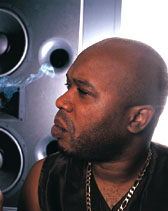 |
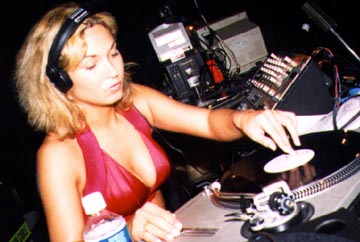
|
DJ Rap Amazingly for someone who sees DJing largely as the path to stardom, DJ Rap is unquestionably one of the fiercest, most ass-kicking drum 'n' bass DJs on the circuit. Then again, she was I taught how to mix by one of the kings of jump-up, Cool Hand Flex, so her skills shouldn't come as too much of a surprise. As with most of the other big names of drum 'n' bass, however, trying to walk the fine line between staying true to a populist underground and fulfilling goals of cross-over success is becoming increasingly difficult for Rap. The erstwhile Charissa Saveiro was born in Singapore and moved to England at the age of 12. A few years later, she ran away from home and was turned on to raving by the squatters she lived with. In 1990 she produced her first track, "Ambience -The Adored", which featured her own vocals and started DJing at venues like London's Astoria club and raves like Sunrise and Raindance. "Divine Rhythms" (1993) furthered her reputation, but it was "Spiritual Aura" (1993) that made Rap's name. A collaboration with Aston under the nom de disque Engineers Without Fears, "Spiritual Aura" was one of the first Ambient Jungle tracks, but unlike the oceanic vibes of LTJ Bukem's "Music", "Spiritual Aura" seemed to spread out Hardcore's delirious bliss and make it more sensual. It may now sound like a precursor to one of Brian Transeau's overgrown epic House tracks, but at the time it heralded a new era. Rap started her own Proper Talent label with the invigorating Digable Bass and Total Tangent EPs (both 1994). A big booyacka anthem that sampled Public Enemy's sirens, "Intelligent Woman" (1994) was Rap's first flirtation with quasi-feminist messages and succeeded admirably. After a disappointing mix album for the Journeys By DJ series, Rap released her debut album, Intelligence (1995), which was a compelling blend of wailing divas, female ragga toasting and Hardstepping beats that was let down only by the lame ballad at the end of the record. Straight-ahead Ragga Jungle followed in the form of the floor-fillers "Roughest Gunark" (1995) and "Rumble" (1996). She started her Low Key imprint with more roughneck bizness courtesy of Special K & Rough Kut's scorched-earth "Give It to 'Em" (1996). Even more over-driven basslines and gangsta poses followed with Special K's "Knowledge/Pressure Roll", Rap's "Presenting the DJ" (1997) and the low-end boomer "NRG/Jacobi" (1998). Her trademark rolling beats and bellowing basslines were nowhere to be found on her album for Sony off-shoot Higher Ground, however. There were some chugging two-steps on Learning Curve (1998), but it was largely a clumsy affair designed to show off Rap as a singer- songwriter complete with muddled pop arrangements and guitar doodling. |